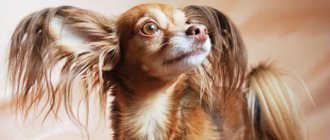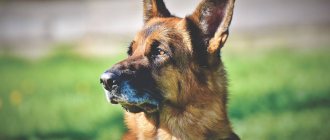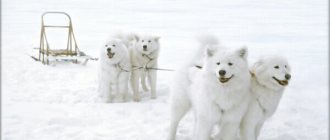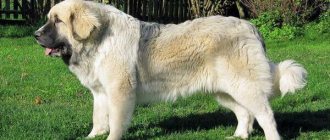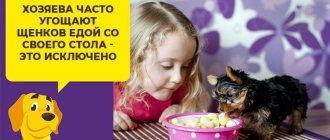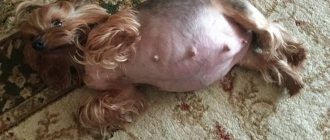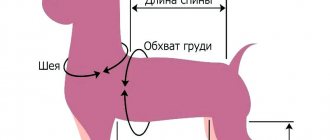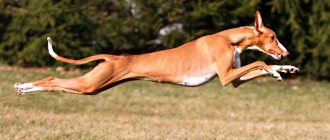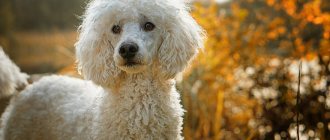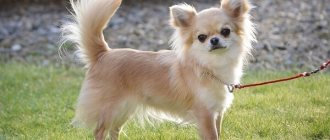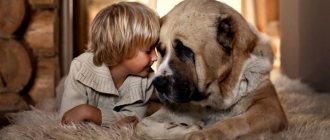History of the Russian Toy Terrier breed
Smooth-haired Russian Toy Terrier
The ancestors of Russian Toys were English Toy Terriers, who gained fame as incomparable rat catchers. The first representatives of this venerable family appeared in Russia back in the era of Peter the Great, and by the middle of the 19th century, small but extremely playful dogs turned into the favorite pets of the domestic elite. Toy terriers lived in imperial residences, guarded the chambers of wealthy landowners, traveling to balls and social events with their arrogant mistresses.
With the advent of Soviet power, decorative dogs migrated to the category of “bourgeois excesses”. The new government gave preference to more useful breeds aimed at full-fledged service and protection, so for almost half a century, toy terriers remained in the shadows, gradually dying out and degenerating.
In the 50s, Soviet cynologist enthusiasts decided to revive the tribe of legendary salon dogs. But since there were no purebred representatives of the toy terrier family left in the USSR by that time, specialists had to work with animals without pedigrees and individuals taken by Soviet soldiers from Germany as war trophies. An additional difficulty was that the offspring obtained during the experiment could not be compared with the cubs of English terriers due to the Iron Curtain policy. As a result, domestic experts did not suspect for a long time that they had bred a new breed, significantly different from the one they were initially targeting. For example, toy terriers of the Soviet “spill” were one and a half times smaller than their British counterparts, had different body proportions and skull shape.
Longhaired Russian Toy Terrier
However, the discoveries did not end there. In 1957, in a family of Russian Toys, where one of the parents was not purebred, a male puppy was born with long feathering of fur in the area of the ears and paws. The animal looked so cute and funny that the breeders decided to keep this attractive mutation, leaving the puppy for the breed. This is how an independent branch of the breed appeared - the Moscow Longhaired Toy Terrier.
Despite their sharply increased popularity, Russian Toy Terriers remained “local” pets for quite a long time, practically unknown outside the country. And only in 2006, the International Canine Association, reluctantly and with reservations, recognized salon dogs as an independent breed. At the request of the FCI commission, Russian Toy Terriers were renamed Russian Toys and received the right to participate in world and European championships.
An interesting fact: among the famous owners of these “toy” dogs are Alla Pugacheva, Garik Kharlamov, Sergey Lazarev, Christina Aguilera and Diana Gurtskaya.
Appearance of the Russian Toy Terrier
Russian Toys are small dogs weighing up to 3 kg. The average height of an individual is 20-28 cm, but often so-called mini-animals are born, whose height may be several centimeters lower than allowed by the standard. Despite such miniature parameters, Russian Toy Terriers look very elegant, which is partly due to their thin skeleton and lean muscles.
Head
Russian Toy puppy
The skull is small, but at the same time high and moderately wide. The cheekbones are flattened and slightly pronounced. The muzzle is dry, pointed. The transition from the forehead to the muzzle is clearly “drawn”. The lips are black and thin. The nose is medium-sized, black, or to match the main color of the animal.
Jaws
The Russian Toy Terrier has a scissor bite and small white teeth. The absence of several incisor teeth is allowed (two incisors for each jaw).
Eyes
Round, large, slightly convex. The landing is straight. The distance between the eyes is wide. The shade of the iris may vary.
Ears
The ears of a toy terrier are large and thin at the same time. Standing. Standing tall.
Neck
Slightly curved, long. Set high.
The muzzle of a Russian toy
Body
The back is strong and level with a smoothly descending top line from the withers to the tail. Body with a rounded croup. The abdomen is tucked, the lumbar region is short and convex. A selected groin makes the lower line of the body taut and curved. The chest is not wide, but deep.
Limbs
The front legs are straight, set parallel to each other. The muscles of the limbs are dry, the elbows look back. The length of the shoulders coincides with the length of the shoulder blades. The glenohumeral angle is 105°. The hind limbs are slender, straight (when viewed from behind), and set slightly wider in relation to the forelimbs. The muscles of the thighs are developed, but dry. The shins and thighs are the same length. The paws are small, oval-shaped, arched, and gather in a “lump.” The front legs are slightly wider than the hind legs. The pads are black, or repeat the main body color, and are elastic.
Tail
Exhibition Winner
In Toy Terriers, both docked and natural variants are allowed. The docked tail is usually short (recommended length - no more than 3 vertebrae), directed upward. The undocked one has the shape of a sickle or crescent, and is held at the level of the back, sometimes higher.
Wool
The characteristics of the coat directly depend on the type of individual. Shorthaired Russian Toy Terriers have a smoother coat that lies close to the body, characterized by an almost complete absence of undercoat.
In long-haired animals, the guard hair is longer, within 3-5 cm. The fur fits tightly to the skin in the body area. The hair has a slightly wavy or straight structure; the ears have a fringed coat. In adults, a flowing “fringe” hides the edges and tips of the ears. The back side of the limbs is decorated with so-called brushes. Soft, lush hair also grows in the paw area, covering the dog’s fingers and claws.
Color
Purebred individuals are distinguished by rich red, fawn, brown and black and tan, as well as lilac and blue and tan colors.
Rock defects
Disadvantages of the breed include any non-compliance with the standard of appearance. These are usually: excessively tall (above 28 cm), straight bite, semi-erect ears and a low-set tail. The presence of white markings on the paws and in the chest area, as well as monocolors (blue, brown, lilac, black) are not welcome.
The main disqualifying faults of Russian Toy Terriers
- The presence of bald spots in short-haired individuals, and the absence of fringed hair on the ears in long-haired individuals.
- Insufficient weight – less than 1 kg.
- Marble, spotted and white colors, as well as the presence of brindle markings.
- Aggression or cowardice.
- Short legs.
- Drop ears.
- Malocclusion.
- Absence of canines and more than 2 incisor teeth in each jaw.
How to determine the age of a toy terrier
The number of years of the pet is indicated by:
- condition of teeth, coat;
- muscle tone;
- behavior.
If the puppy is taken from a conscientious breeder and raised correctly from the moment of purchase, then it will be easier to track changes.
A number of factors influence the accurate assessment of a dog's age:
- conditions of detention;
- nutrition;
- illness;
- bite.
Newborn puppies have a toothless mouth. After 20-25 days, the toy terrier develops fangs and milk hooks. Then the dog undergoes the following changes:
- It takes up to two months for the rest of the teeth to grow. During this time, and sometimes longer, the puppies live with their mother;
- from 2-4 – incisors change (front hooks);
- from 3-5 premolars (middle teeth);
- from 4-6 – edges;
- at 6 – fangs are renewed.
A one-year-old puppy's teeth have characteristic cusps. Based on their abrasion, the subsequent age of the toy terrier is determined. The color of the enamel also changes over time - it turns yellow. The dog's fangs become dull and shorter.
As a Toy Terrier ages, its teeth begin to fall out. Just like people, dogs develop diseases: caries, stones. To help an old friend, it is advisable to consult a doctor. The situation can be corrected through treatment, strengthening, and cementing.
To determine the age of an animal, the state of muscle tone is important. In aging dogs, muscle tissue atrophies or develops obesity. Pets rest and sleep more.
They also look at the condition of the coat, the clarity or dullness of the toy’s eyes.
Character of the Russian Toy Terrier
Russian Toy with owner
Russian Toy Terriers are pets that can dispel any blues. Active, affectionate and emotional, they are ready to frolic and play pranks all day long. These temperamental kids require a lot of attention and constant “feedback”, so when buying a Russian Toy, prepare for the fact that peace and solitude will forever disappear from your home as soon as the animal crosses its threshold. Representatives of this breed are completely non-aggressive, which does not in the least prevent them from being excellent watchmen, warning with their ringing bark about the arrival of an uninvited (and often invited) guest. Among breeders, Russian Toy Terriers are considered to be very smart and skilled manipulators. If the owner, smitten by the sweet appearance of the pet, gives up, there is no doubt: the animal will find a way to use this loyalty to its advantage.
The specific characteristics of the breed include the psycho-emotional instability of its representatives. Russian Toy Terriers easily get turned on by the slightest rustle and take a long time to calm down. As a rule, excitement is accompanied by increased activity of the animal and prolonged barking. Of the unusual talents of miniature dogs, their amazing memory abilities are of particular interest. In particular, Russian Toi are able to store in their memory events that happened three years ago. Often an animal can remember and identify a person it has met only once.
Education and training
There are no special methods for teaching basic commands for Russian Toy Terriers, so standard training techniques are used for them. However, these dogs do not perceive the authoritarian style of influence well. The animal gets scared, withdraws into itself, or, on the contrary, tries to be cunning, which negatively affects the formation of its character. In general, representatives of this breed are not the most diligent students, so you should not hope for lightning-fast success in mastering commands. Of course, with enough patience and perseverance, toys can be taught all the necessary skills, it will just take a little more time to achieve the final result than, for example, when training shepherds.
Puppies under the age of 6 months require especially reverent treatment: no matter how the pet annoys you with its pranks, punishment is not applied to it. If the puppy's poor performance during training causes irritation, it is better to postpone the training. However, you shouldn’t overindulge your pet’s whims either. As much as you might want to, don't let your dog sleep in your bed. Representatives of this breed have rather weak bones, for which even a simple jump from a bed can result in serious injury. And of course, don’t forget about the systematic rewards that help simplify the training process and quickly achieve your goals.
How to stop a Russian Toy Terrier from barking
Frantic barking is considered the main drawback of the breed. Toy terriers bark often and a lot, and the reasons for such “opera arias” can be the most insignificant. Do not try to calm an excited dog by stroking and gentle coaxing. A cunning pet will see this as encouragement and will try even harder. Painful techniques and surgical intervention are fraught with a negative impact on the already unstable psyche of the dog.
Usually barking is stopped with a command (“Ugh!”, “You can’t!”), pronounced in a stern tone. Sometimes the ban is accompanied by a light slap of the animal with a newspaper. In some cases, the ignoring method is used. When the dog starts barking, the owner deliberately distances himself and tries not to look at him. As a rule, not receiving outside support, they cancel the concert. The latter technique is considered alternative and energy-intensive, since it takes more time and nerves of the owner to develop the skill than when using a command technique. In addition, ignoring does not work in cases of older puppies that have not been raised before. Such animals are already accustomed to causing a commotion, so they are unlikely to monitor the owner’s behavior.
How to stop a Russian Toy from biting
From an excess of emotions, Russian toy terriers often bite their owners. Despite the fact that such injuries do not cause serious harm to health, you should not indulge your pet. You can wean your animal off a bad habit with a slight cry of “Ouch!”, signaling the infliction of pain. If the incident occurs during the game, stop the gameplay and leave your pet alone for a while so that he understands that he made a mistake. Do not hit the dog under any circumstances, this will only make things worse.
Russian toy terrier in winter clothes
Care and maintenance
Due to its charming appearance and tiny dimensions, the Russian Toy Terrier resembles a funny toy, which is difficult to perceive as a full-fledged adult animal. Regulars of Instagram and themed photo shoots, these dogs are increasingly turning into a fashion accessory and living advertisement of their owner. Manufacturers of clothing for dogs also add to the artificial excitement by making entire collections of outfits and shoes for toys. However, experienced breeders do not recommend getting too carried away with fashion shows. It is enough to purchase several insulated overalls for your pet for the autumn-winter season. But “packing” a living creature into tight dresses, and even more so, into boots, is clearly unnecessary.
Important: the characteristic trembling characteristic of representatives of the Russian Toy breed is not an indicator of hypothermia. Usually dogs tremble from excess emotions and overexcitement.
Hygiene
Don’t go to extremes and clean your pet’s ears every day. If there are no foreign objects or contaminants in the ear funnel, the hygienic procedure is carried out once a week, using boiled and cooled vegetable oil and a cotton pad, or cleaning lotion from a veterinary pharmacy. Once or twice a week, dogs have their teeth brushed with a special toothpaste or chalk powder with soda and lemon juice. Adult animals should have their nails trimmed once every 15-20 days. 10-day-old puppies also have their nail plates trimmed to prevent the cubs from injuring their mother.
The Russian Toy does not require the services of a breeder or daily brushing (with the exception of long-haired individuals). It is enough to regularly remove dirt from the coat with a cleaning mitten. Too frequent water treatments can dry out your pet’s skin and cause bald spots, so experts recommend bathing Russian Toy Terriers once every six months. Puppies under 6 months of age are strictly prohibited from bathing.
Feeding
There are three options for feeding Russian toys: “natural”, “drying” and a mixed diet. In the first case, the animal’s daily “menu” should include meat (preferably beef), fermented milk products (no more than 3% fat), sea fish fillet, cereal products, egg yolk, vegetables and fruits. Each dog’s “meal” should consist of 1/3 animal protein (meat, fish) and 2/3 cereals, vegetables and dairy products. The volume of each serving is based on 50-80 grams per kilogram of dog weight.
From time to time it is useful to treat your pet with rye crackers and vegetable oil in the amount of 1 teaspoon per day. A couple of times a month they give a clove of garlic, which works as an anthelmintic. Bread, smoked meats, bones, exotic fruits, egg whites and river fish are strictly prohibited.
In the case of dry food, preference is given to varieties that contain at least three types of cereals, vegetables, fruits and at least three animal proteins. Options with soy, yeast additives, wheat and corn are best avoided. Adults are given food twice a day, combining it with a vitamin-mineral complex selected by a veterinarian.
Toilet
Russian toy terriers do not get used to the litter box right away, and sometimes they don’t get used to it at all, so often the only possible toilet option for a dog is a diaper (newspaper). Monitor your puppy closely during the first months of life. In particular, after sleeping, feeding and playing, be sure to put him in a diaper or in a tray to catch the moment when the baby is about to relieve himself. After each “puddle” made in the right place, the pet is supposed to be praised and treated. A fairly effective way is to place the dog in an enclosure with a tray, thus limiting its habitat. Usually the puppy quickly realizes that having a toilet next to his own bed is not a good idea, and uses the litter box.
Russian-toy
Quality content
Caring for the coat of the Smooth-haired Toy Terrier is very simple - you only need to brush it once a week. A long-haired pet should be combed regularly with a comb, making sure that the hair does not get tangled.
Dogs of this breed should be bathed only if they are very dirty; in all other cases, it is better to limit yourself to washing their paws after a walk.
It is also better not to touch the eyes and ears unless necessary. They need to be inspected every day, but cleaned only when dirty.
Nails are trimmed once a month for adult animals and once every 2 weeks for puppies.
NOTE!
Toy terriers' teeth require special attention, as tartar easily forms on them and there is a tendency for them to fall out early.
To prevent this from happening, you need to regularly let your toy terrier chew on soft cartilage or special toys purchased in the store. If necessary, teeth can be cleaned with a brush and toothpaste for dogs.
Health and diseases of the Russian Toy
The average Russian Toy Terrier lives from 10 to 15 years, although history has recorded cases where individual representatives of this genus lived to reach their 20th anniversary. The most common diseases of Russian Toys are cataracts, retinal atrophy, subluxation of the patella, and hydrocephalus. Pancreatitis is quite common, resulting from attempts to diversify a dog’s diet with pickles and fatty smoked meats.
Particular danger lies in the fragile thin bones and excessive mobility of the animal, so representatives of this breed are injured easily and often. Some individuals may have a genetic abnormality such as avascular necrosis of the femoral head. Usually the disease leads to lameness of the pet, and if left untreated, to complete atrophy of the hind limbs.
Main types
The table shows the main varieties of toy terriers and their descriptions:
| View | Description |
| Russian toy terrier | The breed was recognized by the FCI in 2006. Modern Moscow Toys are small, long-legged dogs with a small apple-shaped head, a dry, elongated muzzle, large bulging eyes, high-set triangular ears and a high-set tail. Height at the withers is 20-26 cm, weight 2-3 kg. There are 2 varieties: long-haired and smooth-haired |
| English toy terrier | Elegant dogs, 25-30 cm tall and weighing 2.7-3.6 kg. They have a narrow muzzle, an elongated skull, and erect ears. The coat is thick, short, and fits tightly to the body. Only black and tan color allowed |
| American Toy Terrier | A breed still unrecognized by the FCI. When breeding, they used smooth fox terriers, English toy terriers and Chihuahuas. The height of these dogs is 24-25 cm, weight - 1.5-3.5 kg. They have a small head, large triangular erect ears, a short tail and a shiny coat, colored in 2 or 3 colors: white with black and (or) red spots on the head and rump |
How to choose a puppy
Choose an affectionate, easy-going animal at the age of 2.5, or preferably 3 months. During this period of life, the puppy's weight should be about 1.5 kg. If the dog weighs 600 g or less, most likely they are trying to sell you a defective dwarf dog. Try to get the most complete information about the puppy’s pedigree, even if you are going to purchase a Russian Toy Terrier of the pet category.
Reasons to be wary:
- the puppy is shown in a cage without being released from it;
- the animal's fur has bald spots;
- the dog has overly bulging eyes or slight squint, which is often a sign of increased intracranial pressure;
- there is discharge from the nose and eyes;
- the puppy does not have a veterinary passport.
Features of the mini breed
Due to their small size, toy terriers are suitable for home keeping. Dogs are different:
- cheerful character and mobility;
- have sensitive hearing;
- react instantly to the appearance of “strangers”;
- loyal and fearless.
Known toy breeds:
- English;
- Yorkshire;
- American Toy Fox Terrier;
- Australian;
- Russian.
Small individuals are not officially recognized as a species.
Description of the standard toy:
- head with a high skull, narrowed muzzle;
- dry, straight back;
- deep chest;
- toned stomach;
- tail (docked 2-5 cm);
- the skin fits the body;
- the front legs are slender, stand parallel to each other, the hind legs are set wider;
- the coat is shiny, even - straight or slightly curly, while the contours of the body are not hidden;
- There are featherings on the ears and back of the paws.
Division of toy terriers by weight:
- standard – up to 2 kg;
- mini - up to 1.7 kg;
- adult supermini dog – up to 1.3 kg.
Useful article: All about the Russian Toy Terrier
The color of English Toys is black with bright tan, and the color of Russian dogs is:
- red with black, brown coating;
- black, bluish, lilac and tan;
- pale yellow.
Ability to reproduce
Dwarf individuals rarely become pregnant. Girls from 23 cm at the withers are suitable for the birth of offspring.
A bitch usually has 1-3 puppies in a litter. A competent doctor must be present during childbirth. The weight of newborn toy terriers is 80-190 grams.
Photos of Russian Toy puppies
How much does a Russian Toy Terrier cost?
You can buy a Russian Toy Terrier puppy in nurseries for 20,000 – 50,000 rubles. Cheaper options can be found in the advertisements. In this case, the price of an animal with the RKF metric will be from 12,000 to 17,000 rubles. In addition, the cost is affected by the class, gender and color of the dog. Although the sexual type of Russian Toys is weakly expressed and the external characteristics of males and females are approximately the same, the latter will cost significantly more. Of the entire palette of colors, lilac-tan and blue-tan are considered the most scarce and, accordingly, expensive. The cheapest color option is red.
How long do mini and micro toy terriers live?
The lifespan of the mini and micro varieties of toy terriers is shorter than that of the standard breed.
This is due to the vulnerability of these tiny dogs, as well as the fact that they tolerate any diseases worse than their larger standard-sized relatives. Increased trauma associated with the small size of the pet and its high mobility can also cause the early death of a mini- or micro-toy terrier.
IMPORTANT!
The average life expectancy of dwarf varieties of toy terrier is short and is only 3-5 years, and a lot depends on how carefully the owners treat their pets.
